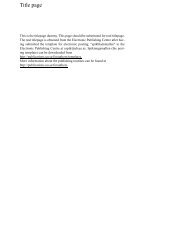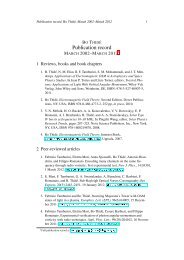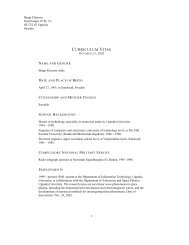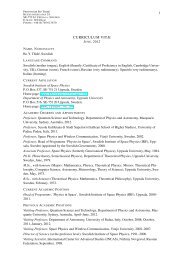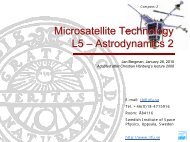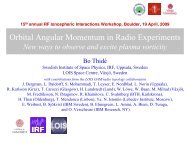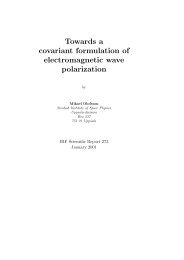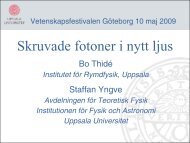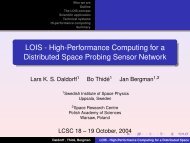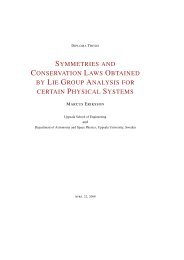Atmosphere-Ionosphere Mission - Swedish Institute of Space ...
Atmosphere-Ionosphere Mission - Swedish Institute of Space ...
Atmosphere-Ionosphere Mission - Swedish Institute of Space ...
You also want an ePaper? Increase the reach of your titles
YUMPU automatically turns print PDFs into web optimized ePapers that Google loves.
TECHNOLOGY 16<br />
FIGURE 8: The DIXI system Angie chip developed at Department <strong>of</strong> Radiation<br />
Research at Uppsala University.<br />
will provide sensors for extremely high frequencies/energies and expertise in the<br />
detection <strong>of</strong> high-energy photons and particles.<br />
The Digital X-ray Imaging project (DIXI) at the ISV has developed a readout<br />
circuit with 31 ×32 pixels each consisting <strong>of</strong> a pre-amplifier, shaper, discriminator<br />
and two counters [24]. The chip itself can be viewed in Figure 8 and the detector<br />
board, with the Angie chip mounted, can be viewed in Figure 9. The circuit is<br />
designed for subtractive imaging with single photon counting capabilities. The<br />
radiation hardened electronics, which is being used in particle accelerator experiments,<br />
is implemented as a integrated circuit so the instrument will be compact<br />
and light-weight. The sensitivity to photons can be tuned by selecting an appropriate<br />
sensor element, typically a flip-chip bonded to the circuit, and by setting<br />
the discrimination threshold in the discriminator. In the DIXI project the energy<br />
range 5–100 keV is covered. The technology is also easily applicable to charged<br />
particles. One <strong>of</strong> the satellites <strong>of</strong> the proposed set <strong>of</strong> two, will be equipped with<br />
this sensor while the other craft will have a gamma detector, also provided by ISV.<br />
Innovative digital electromagnetic field vector receptors (‘three-dimensional<br />
radio antenna and receiver systems’) have been developed in a collaboration between<br />
the IRF group (led by Bo Thidé), the group at Signal and Systems (led by pr<strong>of</strong>essor<br />
Anders Rydberg) in Uppsala, and the group at Växjö University (led by pr<strong>of</strong>essor<br />
Sven Nordebo). This combination <strong>of</strong> expertise and competence will ensure highquality<br />
science and technology.<br />
<strong>Atmosphere</strong>-<strong>Ionosphere</strong> <strong>Mission</strong><br />
Elaborate Science Case



